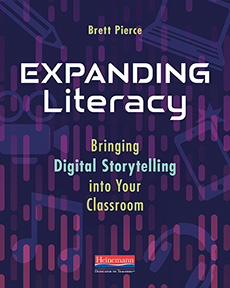Preparing Our Students to Be Digital Storytellers
By Brett Pierce

This article investigates the new form of writing that is emerging as a result – a writing that needs to be wholly integrated into the classroom. But let’s start with some context.
Way, way, way back when, we shifted from an oral culture to a literate culture. The origins of writing can be traced to the late 4th millennium BC where, some scholars argue, it began as a result of an increasingly complex economy in Mesopotamia where transactions could no longer be memorized: they had to be recorded in some fashion (Robinson, Andrew 2007).
The nature of this change is eloquently articulated by Walter Ong, a breakthrough scholar in this realm who had this to say about the emergence of the written word, arguably the first new communication medium beyond the primacy of the voice:
Writing separates the knower from the known and thus sets up conditions for objectivity in the sense of personal disengagement and distancing. … To live and understand fully, we need not only proximity but also distance. This writing provides for consciousness as nothing else does (Ong 1982).
Heavy stuff. But so cool, this idea that one could write a thought and leave it behind; walk away from it. The idea that the thought no longer had to be kept alive by an active mind in order to exist. It can sit and percolate as a sequence of written words, and then someone else can come upon it and …add to it. This just scratches at the surface of how writing changed humanity’s relationship to self and society.

tomislav medak, CC BY 2.0
Fast forward to the start of the twentieth century. Radio, followed by TV, enters into society’s mainstream, reshaping how we spend time and interact, expands our understanding of the larger world and introduces the idea of culturally shared experiences: everyone growing up in the 60’s and 70’s knew Walter Cronkite, Bewitched, and The Jeffersons.
The introduction of television and radio dramatically reconfigured the way we think, perceive, interact and understand, and all of this was foreseen in the mid-sixties by Marshall McLuhan who famously wrote: “For the message of any medium or technology is the change of scale or patterns that it introduced into human affairs” (McLuhan 1964).
My translation: communication technologies universally reprogram our understanding of self and others, and communities and societies; and the more aware we are of this phenomenon, the better able we are to harness and optimize those changes.
And now we have the Internet, which has in turn yielded the many social media platforms of which we are all well aware.
An expanded understanding of literacy
I mention all this not as ground-breaking news, but as a reminder that (a) history has proven that the introduction of communication technologies does indeed change how societies evolve; and (b) we are currently living through one of those seismic societal conversions that used to take hundreds of years – the impact of the printing press, for example – and is now reduced to a matter of a few years.
Amidst this technological maelstrom has evolved an expanded understanding of literacy – of writing and communicating. Text is no longer the only game in town. Digital storytelling – the ‘writing’ side of digital literacy (you can call it multi-modal communication, but I find that phrase enervating) – is, I would argue, of equal educational value to text-based writing.
Why? Because the digital realm is your students’ library. It’s their communication platform. It’s their social life. It’s their source of knowledge. It’s their language. It’s a full-blown communication spectrum the breadth and depth of which is unprecedented in history.
Has there ever been a more all-consuming and far-reaching literacy? Has the need to teach toward ‘writing’ fluency in this literacy ever been greater? The question then is: Are we preparing our kids to be meaningful contributors to this digitally literate universe? And the answer is mostly ‘No.’
So what do I mean by ‘digital storytelling?’
Digital storytelling is the capacity to communicate using text, sound, music, and imagery – still and moving. You don’t have to use all of these tools, but they are the main components of digital storytelling. If we think of this in terms of primary and secondary colors, then text, sound/music and imagery are your primary colors.
Pacing, visual palette, graphics, voice, tone, and genre (comedy, game show, news, mystery, etc.) might be your secondary colors. It’s a relatively vast range of tools with which to work in order to effectively communicate. And in that range lies both its complexity and wonder, challenge and opportunity.
Is digital storytelling teachable without prior media production knowledge? Yes! All you need to know is what you know: the content. The answer to any question from the students about digital production and IT-related activities is this: “You figure it out.”
Here’s the reality. In traditional text-based literacy, you, the educator, know the rules and you teach those rules to your students…whether you are teaching science, math, history, or literature. Text-based literacy is powered by rules of syntax and grammar, word choices and punctuation.
Digital Literacy is not about rules as much as about mechanics. Digital Literacy is about knowing (1) the individual operations of the different digital parts (imagery, music, sound, editing, zooms, etc.); and (2) how those different digital parts all synchronize with each other.
For the students, discovering these digital mechanics – including cool apps that let letters fly or distort an image to comic effect – is like letting them loose in a playground designed just for them. Except it’s digital.
Discovering the various components of digital literacy is part of the learning experience. Teaching you, the educator, what they, the students, have discovered is also a vital part of the learning experience. We all know the power of this flipped classroom model, even in this micro format. But it still takes guts and confidence to yield that control of information and knowledge.
The payoff is huge
One of the many beauties of digital storytelling is the depth of the narrative bench at its disposal.
Well over seventy years of television has yielded myriad narrative forms that can be applied in the classroom. We are talking game shows! Reality shows! Sitcoms! Music videos! Sketch comedies! Dramas! The list goes on. It’s pretty great.
Digital storytelling in the classroom is an invitation to students to utilize their intimate knowledge of television, podcasting, and social media formats to explore curricular content. That is part of the attraction for students – tapping into their practically organic knowledge of these genres of storytelling.
Where it gets really interesting and deeply relevant is inside the streaming world of Vimeo, TikTok, and YouTube. Have you ever thought of these platforms as …libraries? They are. They perform the exact same function as traditional libraries, serving as vital sources of knowledge, content, and entertainment.
But since these platforms are libraries of digital stories and not books, their unique qualities have spawned new narrative formats that transcend television. Popular examples include:
1. How To/Tutorials – The efficient, visually pithy videos that take the viewer through how to…change a sparkplug…create a survey in Google Forms…create a killer curry sauce.
2. Vlogs – This video blogging format allows individuals to relay personal information and societal observations in a casual style.
3. Product Reviews – A subset of vlogs are the product reviews. This format features popular Influencers talking about products that they are trying out, from make-up to shampoo to tech accessories. Product reviews can also take the form of a list or “listicle” that ranks their favorite topics in a certain category. Imagine asking students to create a Product review of … a novel, a current global leader, or your town’s recycling commitment.
4. Crash Course Educational Model – This is that quick cutting, highly scripted talking head video format with graphics that aims to take complex educational content and relay it back in a casual, humorous, story-based style. This style is well represented in the YouTube brand Crash Course from Vlogbrothers John and Hank Green.
All of these different narrative structures champion different storytelling strengths. From the personal journey of the vlog to the focus on voice and character in the radio drama; from the variety of perspectives and expertise in the special news cast (think anchor, color commentator, field reporter and interviewee) to the use of comedy to communicate important, visceral content in the comic sketch, the digital story offers students a seemingly infinite series of creative choices that open portals into understanding and communicating serious content, inside of the digital universe in which they spend half of their lives.
Preparing students to be digitally meaningful
In the end, if we are to properly prepare our students for life after secondary school, we need to set them up to succeed digitally, to communicate meaningfully inside the digital landscape of stories, and to contribute responsibly to these new libraries of digital stories.
This means consistently experimenting with text, sound, music, imagery, voice, story, tone, perspective, narrative format, time, color, …the list goes on. And to do this, the students need to collaborate, create, think critically, problem solve, work iteratively, present publicly, manage time and schedules, make decisions, master digital apps, …that list goes on too.
The educational value should be clear and inexorable. And here’s the final killer piece to it all. For the students…it’s a blast!


Brett recently wrote Expanding Literacy: Bringing Digital Storytelling into Your Classroom from Heinemann (read our review here) and the new National Geographic Storytelling for Impact course series for educators which won the Gold Anthem Award in 2022.
Brett has spent much of his professional life at Sesame Workshop in New York City, serving as a producer on media projects about literacy, math, science, and conflict resolution for youth around the world.































